Новая Зеландия.pptx
- Количество слайдов: 23
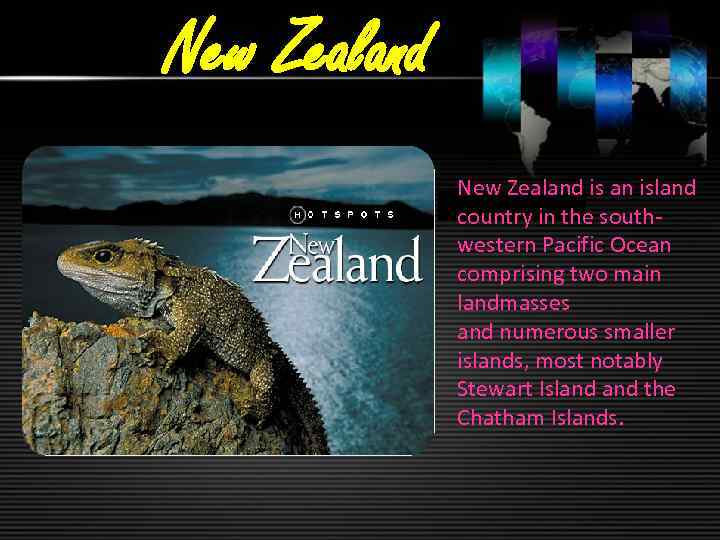 New Zealand is an island country in the southwestern Pacific Ocean comprising two main landmasses and numerous smaller islands, most notably Stewart Island the Chatham Islands.
New Zealand is an island country in the southwestern Pacific Ocean comprising two main landmasses and numerous smaller islands, most notably Stewart Island the Chatham Islands.
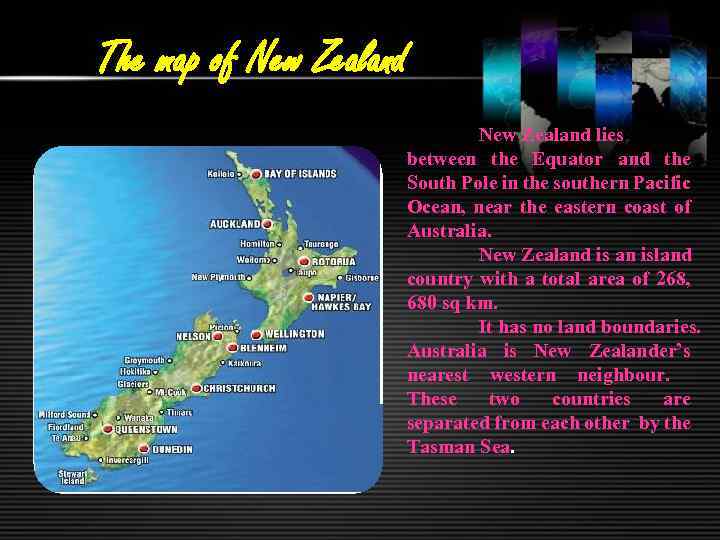 The map of New Zealand lies between the Equator and the South Pole in the southern Pacific Ocean, near the eastern coast of Australia. New Zealand is an island country with a total area of 268, 680 sq km. It has no land boundaries. Australia is New Zealander’s nearest western neighbour. These two countries are separated from each other by the Tasman Sea.
The map of New Zealand lies between the Equator and the South Pole in the southern Pacific Ocean, near the eastern coast of Australia. New Zealand is an island country with a total area of 268, 680 sq km. It has no land boundaries. Australia is New Zealander’s nearest western neighbour. These two countries are separated from each other by the Tasman Sea.
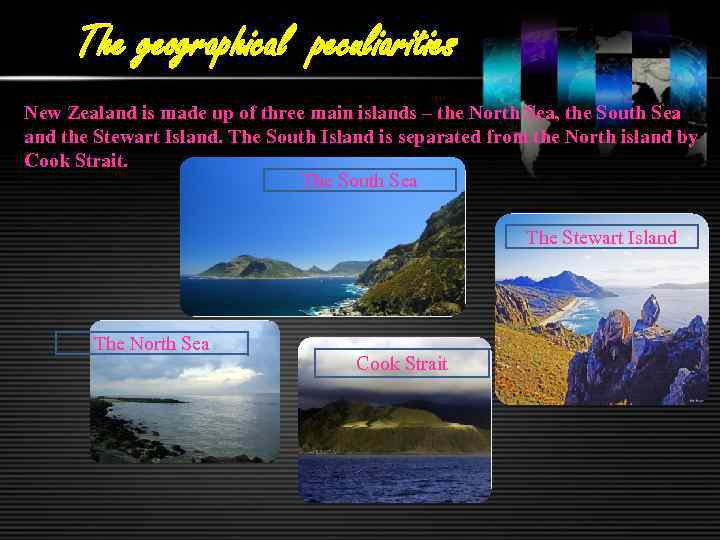 The geographical peculiarities New Zealand is made up of three main islands – the North Sea, the South Sea and the Stewart Island. The South Island is separated from the North island by Cook Strait. The South Sea The Stewart Island The North Sea Cook Strait
The geographical peculiarities New Zealand is made up of three main islands – the North Sea, the South Sea and the Stewart Island. The South Island is separated from the North island by Cook Strait. The South Sea The Stewart Island The North Sea Cook Strait
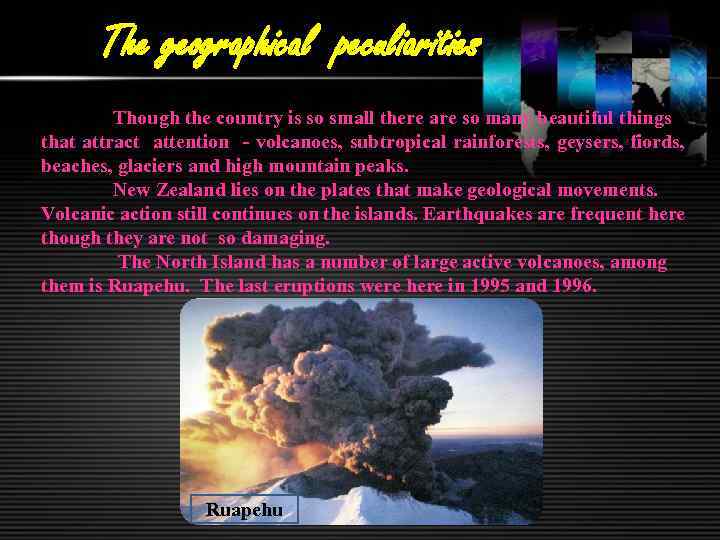 The geographical peculiarities Though the country is so small there are so many beautiful things that attract attention - volcanoes, subtropical rainforests, geysers, fiords, beaches, glaciers and high mountain peaks. New Zealand lies on the plates that make geological movements. Volcanic action still continues on the islands. Earthquakes are frequent here though they are not so damaging. The North Island has a number of large active volcanoes, among them is Ruapehu. The last eruptions were here in 1995 and 1996. Ruapehu
The geographical peculiarities Though the country is so small there are so many beautiful things that attract attention - volcanoes, subtropical rainforests, geysers, fiords, beaches, glaciers and high mountain peaks. New Zealand lies on the plates that make geological movements. Volcanic action still continues on the islands. Earthquakes are frequent here though they are not so damaging. The North Island has a number of large active volcanoes, among them is Ruapehu. The last eruptions were here in 1995 and 1996. Ruapehu
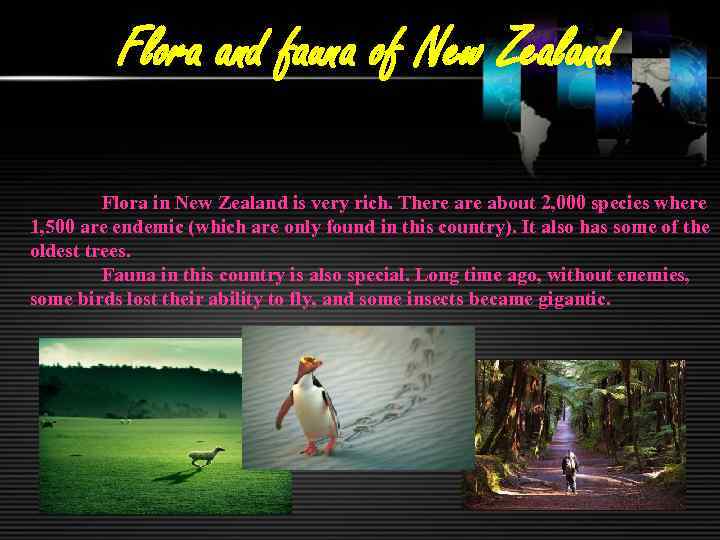 Flora and fauna of New Zealand Flora in New Zealand is very rich. There about 2, 000 species where 1, 500 are endemic (which are only found in this country). It also has some of the oldest trees. Fauna in this country is also special. Long time ago, without enemies, some birds lost their ability to fly, and some insects became gigantic.
Flora and fauna of New Zealand Flora in New Zealand is very rich. There about 2, 000 species where 1, 500 are endemic (which are only found in this country). It also has some of the oldest trees. Fauna in this country is also special. Long time ago, without enemies, some birds lost their ability to fly, and some insects became gigantic.
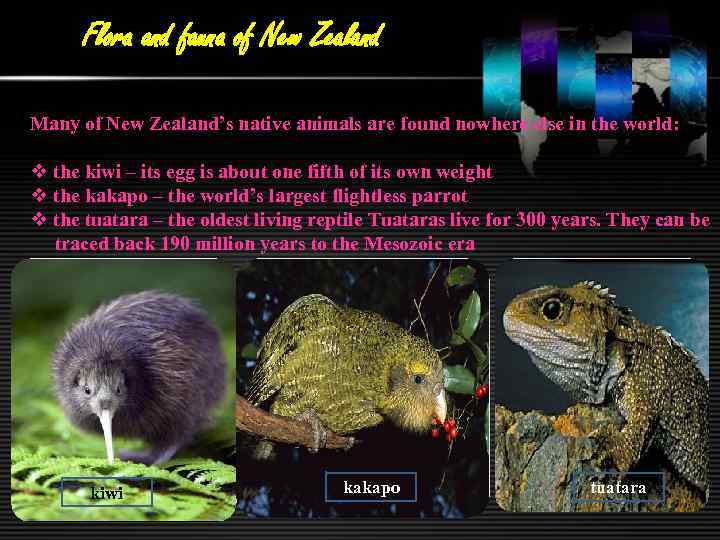 Flora and fauna of New Zealand Many of New Zealand’s native animals are found nowhere else in the world: v the kiwi – its egg is about one fifth of its own weight v the kakapo – the world’s largest flightless parrot v the tuatara – the oldest living reptile Tuataras live for 300 years. They can be traced back 190 million years to the Mesozoic era kiwi kakapo tuatara
Flora and fauna of New Zealand Many of New Zealand’s native animals are found nowhere else in the world: v the kiwi – its egg is about one fifth of its own weight v the kakapo – the world’s largest flightless parrot v the tuatara – the oldest living reptile Tuataras live for 300 years. They can be traced back 190 million years to the Mesozoic era kiwi kakapo tuatara
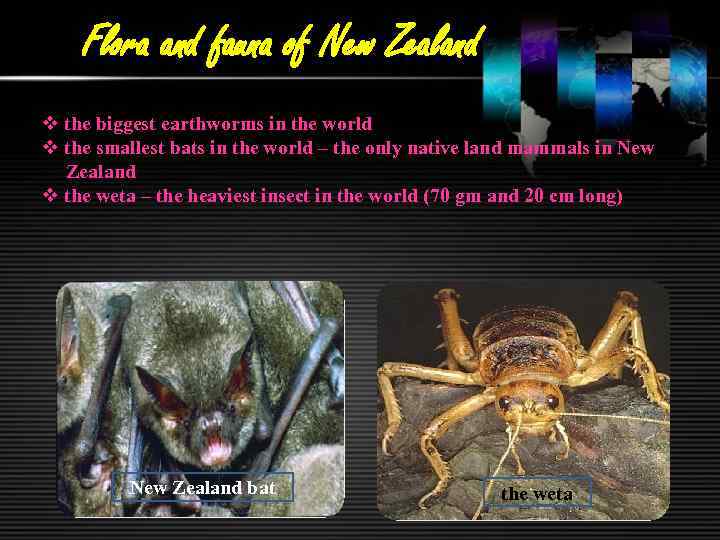 Flora and fauna of New Zealand v the biggest earthworms in the world v the smallest bats in the world – the only native land mammals in New Zealand v the weta – the heaviest insect in the world (70 gm and 20 cm long) New Zealand bat the weta
Flora and fauna of New Zealand v the biggest earthworms in the world v the smallest bats in the world – the only native land mammals in New Zealand v the weta – the heaviest insect in the world (70 gm and 20 cm long) New Zealand bat the weta
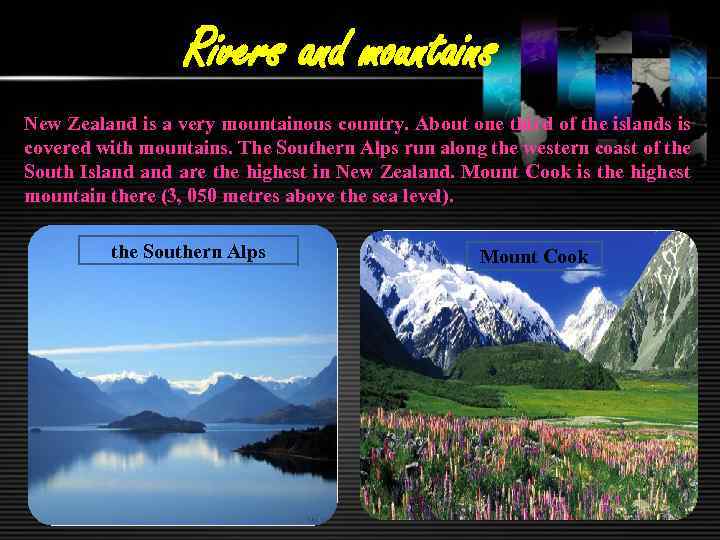 Rivers and mountains New Zealand is a very mountainous country. About one third of the islands is covered with mountains. The Southern Alps run along the western coast of the South Island are the highest in New Zealand. Mount Cook is the highest mountain there (3, 050 metres above the sea level). the Southern Alps Mount Cook
Rivers and mountains New Zealand is a very mountainous country. About one third of the islands is covered with mountains. The Southern Alps run along the western coast of the South Island are the highest in New Zealand. Mount Cook is the highest mountain there (3, 050 metres above the sea level). the Southern Alps Mount Cook
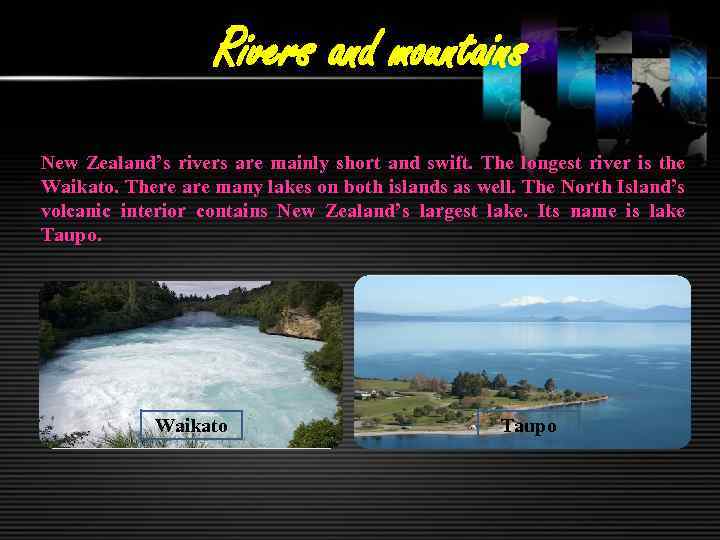 Rivers and mountains New Zealand’s rivers are mainly short and swift. The longest river is the Waikato. There are many lakes on both islands as well. The North Island’s volcanic interior contains New Zealand’s largest lake. Its name is lake Taupo. Waikato Taupo
Rivers and mountains New Zealand’s rivers are mainly short and swift. The longest river is the Waikato. There are many lakes on both islands as well. The North Island’s volcanic interior contains New Zealand’s largest lake. Its name is lake Taupo. Waikato Taupo
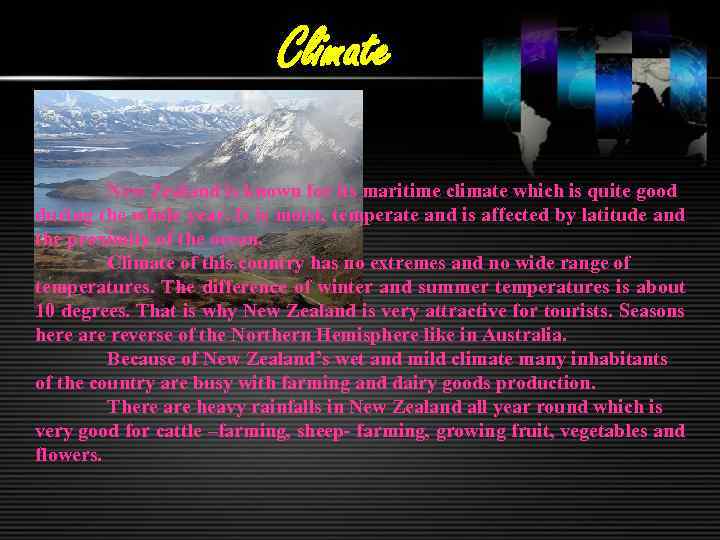 Climate New Zealand is known for its maritime climate which is quite good during the whole year. It is moist, temperate and is affected by latitude and the proximity of the ocean. Climate of this country has no extremes and no wide range of temperatures. The difference of winter and summer temperatures is about 10 degrees. That is why New Zealand is very attractive for tourists. Seasons here are reverse of the Northern Hemisphere like in Australia. Because of New Zealand’s wet and mild climate many inhabitants of the country are busy with farming and dairy goods production. There are heavy rainfalls in New Zealand all year round which is very good for cattle –farming, sheep- farming, growing fruit, vegetables and flowers.
Climate New Zealand is known for its maritime climate which is quite good during the whole year. It is moist, temperate and is affected by latitude and the proximity of the ocean. Climate of this country has no extremes and no wide range of temperatures. The difference of winter and summer temperatures is about 10 degrees. That is why New Zealand is very attractive for tourists. Seasons here are reverse of the Northern Hemisphere like in Australia. Because of New Zealand’s wet and mild climate many inhabitants of the country are busy with farming and dairy goods production. There are heavy rainfalls in New Zealand all year round which is very good for cattle –farming, sheep- farming, growing fruit, vegetables and flowers.
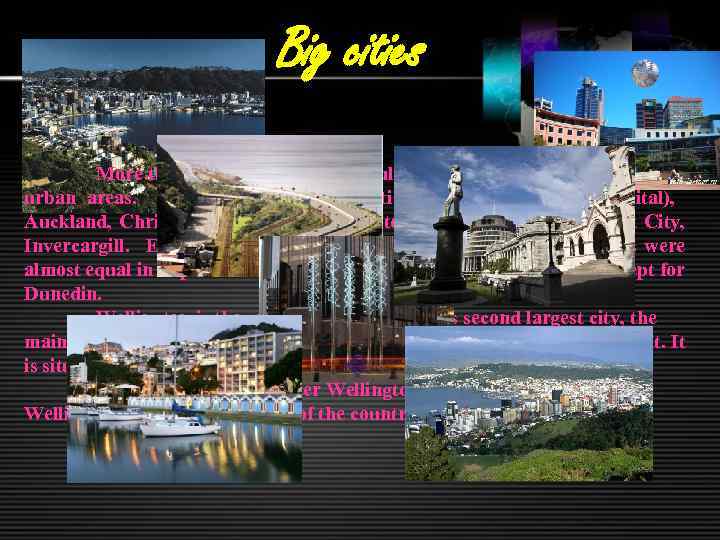 Big cities More than 85 per cent of the population of New Zealand lives in urban areas. The principal country cities are Wellington (the capital), Auckland, Christchurch, Dunedin, Hamilton, Palmerston North, Hutt City, Invercargill. Early in the 20 th century the first four mentioned cities were almost equal in importance but then they started to develop rapidly except for Dunedin. Wellington is the capital of the country, its second largest city, the main port, the centre of finance and commerce and a sit of the government. It is situated on the southern coast of the North Island. The population of greater Wellington is about 350, 000 people. Wellington has been the capital of the country since 1865.
Big cities More than 85 per cent of the population of New Zealand lives in urban areas. The principal country cities are Wellington (the capital), Auckland, Christchurch, Dunedin, Hamilton, Palmerston North, Hutt City, Invercargill. Early in the 20 th century the first four mentioned cities were almost equal in importance but then they started to develop rapidly except for Dunedin. Wellington is the capital of the country, its second largest city, the main port, the centre of finance and commerce and a sit of the government. It is situated on the southern coast of the North Island. The population of greater Wellington is about 350, 000 people. Wellington has been the capital of the country since 1865.
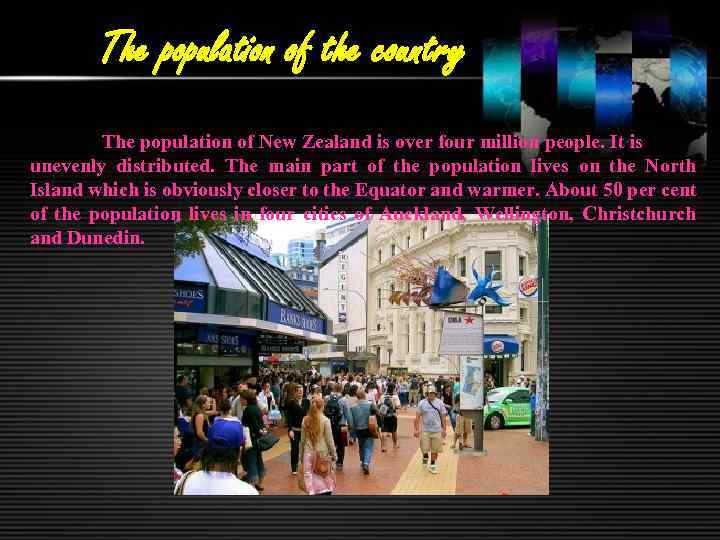 The population of the country The population of New Zealand is over four million people. It is unevenly distributed. The main part of the population lives on the North Island which is obviously closer to the Equator and warmer. About 50 per cent of the population lives in four cities of Auckland, Wellington, Christchurch and Dunedin.
The population of the country The population of New Zealand is over four million people. It is unevenly distributed. The main part of the population lives on the North Island which is obviously closer to the Equator and warmer. About 50 per cent of the population lives in four cities of Auckland, Wellington, Christchurch and Dunedin.
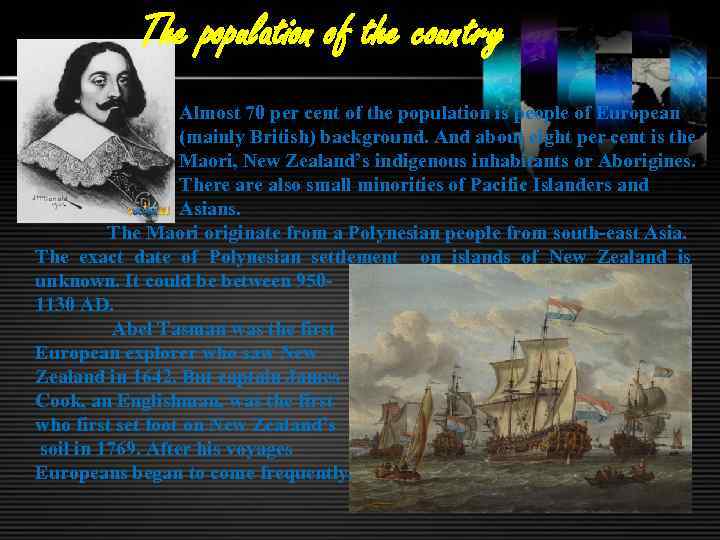 The population of the country Almost 70 per cent of the population is people of European (mainly British) background. And about eight per cent is the Maori, New Zealand’s indigenous inhabitants or Aborigines. There also small minorities of Pacific Islanders and Asians. The Maori originate from a Polynesian people from south-east Asia. The exact date of Polynesian settlement on islands of New Zealand is unknown. It could be between 9501130 AD. Abel Tasman was the first European explorer who saw New Zealand in 1642. But captain James Cook, an Englishman, was the first who first set foot on New Zealand’s soil in 1769. After his voyages Europeans began to come frequently.
The population of the country Almost 70 per cent of the population is people of European (mainly British) background. And about eight per cent is the Maori, New Zealand’s indigenous inhabitants or Aborigines. There also small minorities of Pacific Islanders and Asians. The Maori originate from a Polynesian people from south-east Asia. The exact date of Polynesian settlement on islands of New Zealand is unknown. It could be between 9501130 AD. Abel Tasman was the first European explorer who saw New Zealand in 1642. But captain James Cook, an Englishman, was the first who first set foot on New Zealand’s soil in 1769. After his voyages Europeans began to come frequently.
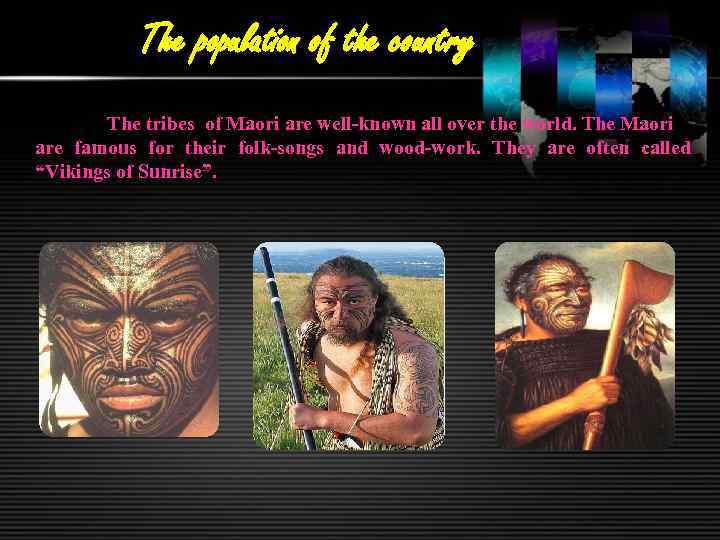 The population of the country The tribes of Maori are well-known all over the world. The Maori are famous for their folk-songs and wood-work. They are often called “Vikings of Sunrise”.
The population of the country The tribes of Maori are well-known all over the world. The Maori are famous for their folk-songs and wood-work. They are often called “Vikings of Sunrise”.
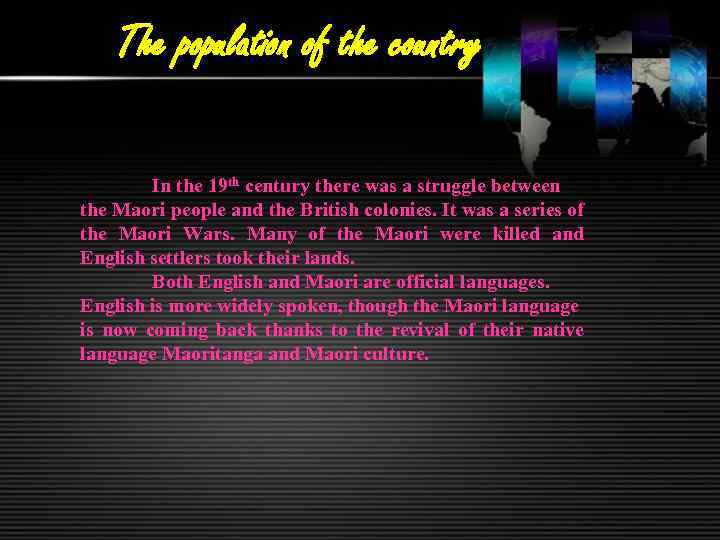 The population of the country In the 19 th century there was a struggle between the Maori people and the British colonies. It was a series of the Maori Wars. Many of the Maori were killed and English settlers took their lands. Both English and Maori are official languages. English is more widely spoken, though the Maori language is now coming back thanks to the revival of their native language Maoritanga and Maori culture.
The population of the country In the 19 th century there was a struggle between the Maori people and the British colonies. It was a series of the Maori Wars. Many of the Maori were killed and English settlers took their lands. Both English and Maori are official languages. English is more widely spoken, though the Maori language is now coming back thanks to the revival of their native language Maoritanga and Maori culture.
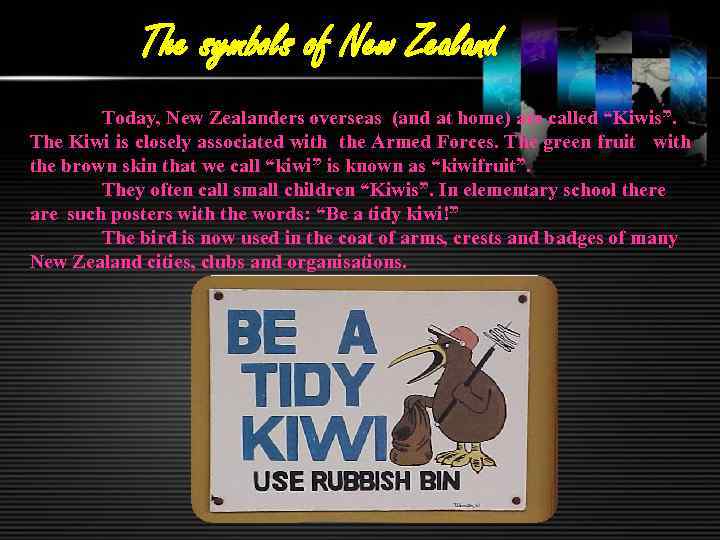 The symbols of New Zealand Today, New Zealanders overseas (and at home) are called “Kiwis”. The Kiwi is closely associated with the Armed Forces. The green fruit with the brown skin that we call “kiwi” is known as “kiwifruit”. They often call small children “Kiwis”. In elementary school there are such posters with the words: “Be a tidy kiwi!” The bird is now used in the coat of arms, crests and badges of many New Zealand cities, clubs and organisations.
The symbols of New Zealand Today, New Zealanders overseas (and at home) are called “Kiwis”. The Kiwi is closely associated with the Armed Forces. The green fruit with the brown skin that we call “kiwi” is known as “kiwifruit”. They often call small children “Kiwis”. In elementary school there are such posters with the words: “Be a tidy kiwi!” The bird is now used in the coat of arms, crests and badges of many New Zealand cities, clubs and organisations.
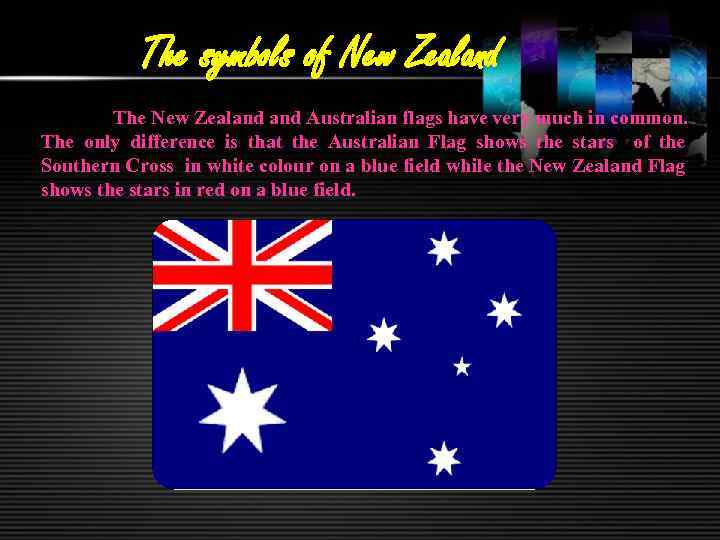 The symbols of New Zealand The New Zealand Australian flags have very much in common. The only difference is that the Australian Flag shows the stars of the Southern Cross in white colour on a blue field while the New Zealand Flag shows the stars in red on a blue field.
The symbols of New Zealand The New Zealand Australian flags have very much in common. The only difference is that the Australian Flag shows the stars of the Southern Cross in white colour on a blue field while the New Zealand Flag shows the stars in red on a blue field.
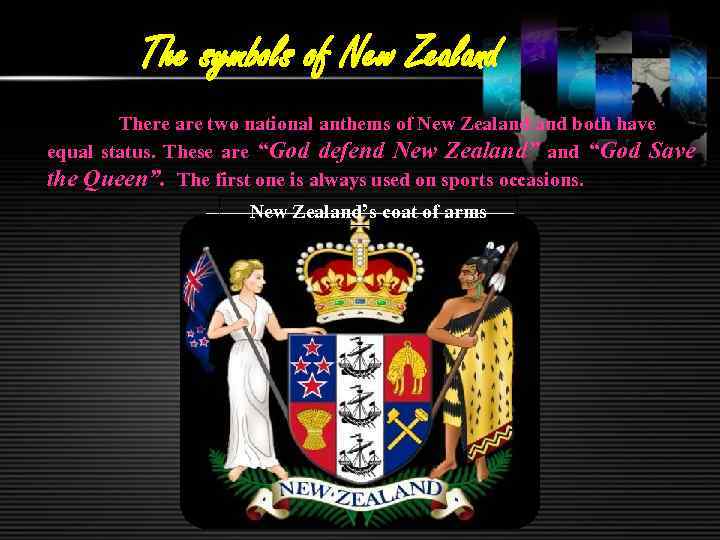 The symbols of New Zealand There are two national anthems of New Zealand both have equal status. These are “God defend New Zealand” and “God Save the Queen”. The first one is always used on sports occasions. New Zealand’s coat of arms
The symbols of New Zealand There are two national anthems of New Zealand both have equal status. These are “God defend New Zealand” and “God Save the Queen”. The first one is always used on sports occasions. New Zealand’s coat of arms
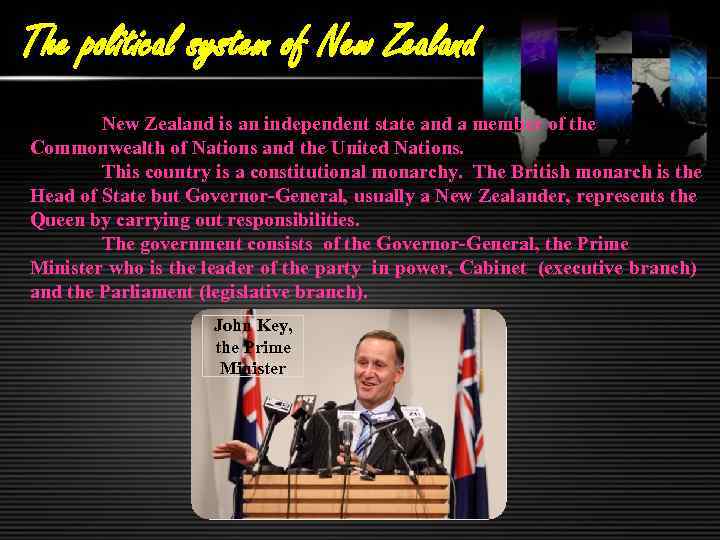 The political system of New Zealand is an independent state and a member of the Commonwealth of Nations and the United Nations. This country is a constitutional monarchy. The British monarch is the Head of State but Governor-General, usually a New Zealander, represents the Queen by carrying out responsibilities. The government consists of the Governor-General, the Prime Minister who is the leader of the party in power, Cabinet (executive branch) and the Parliament (legislative branch). John Key, the Prime Minister
The political system of New Zealand is an independent state and a member of the Commonwealth of Nations and the United Nations. This country is a constitutional monarchy. The British monarch is the Head of State but Governor-General, usually a New Zealander, represents the Queen by carrying out responsibilities. The government consists of the Governor-General, the Prime Minister who is the leader of the party in power, Cabinet (executive branch) and the Parliament (legislative branch). John Key, the Prime Minister
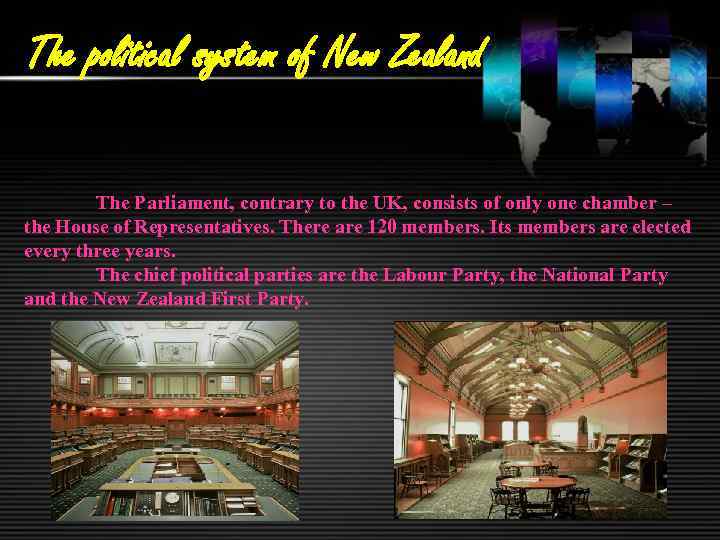 The political system of New Zealand The Parliament, contrary to the UK, consists of only one chamber – the House of Representatives. There are 120 members. Its members are elected every three years. The chief political parties are the Labour Party, the National Party and the New Zealand First Party.
The political system of New Zealand The Parliament, contrary to the UK, consists of only one chamber – the House of Representatives. There are 120 members. Its members are elected every three years. The chief political parties are the Labour Party, the National Party and the New Zealand First Party.
 Some details of culture of New Zealand There is a famous New Zealand dessert called “pavlova” (meringue, cream and kiwi topping). It was invented as a tribute to the Russian ballerina Anna Pavlova who toured to Australia and New Zealand in 1926.
Some details of culture of New Zealand There is a famous New Zealand dessert called “pavlova” (meringue, cream and kiwi topping). It was invented as a tribute to the Russian ballerina Anna Pavlova who toured to Australia and New Zealand in 1926.
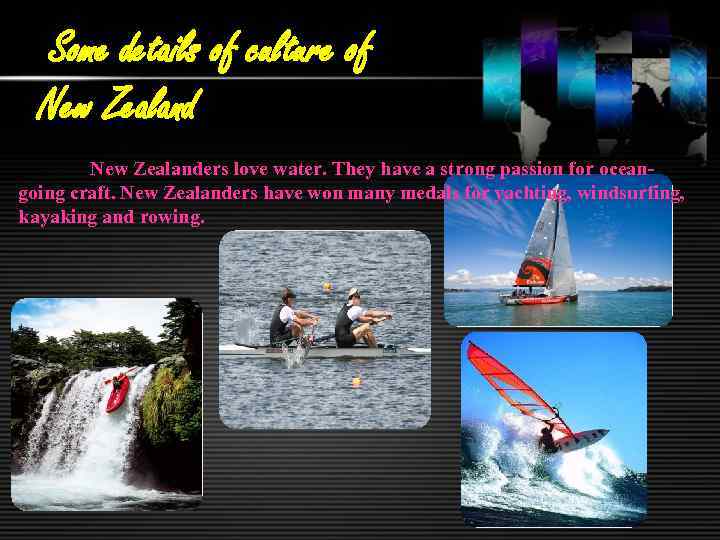 Some details of culture of New Zealanders love water. They have a strong passion for oceangoing craft. New Zealanders have won many medals for yachting, windsurfing, kayaking and rowing.
Some details of culture of New Zealanders love water. They have a strong passion for oceangoing craft. New Zealanders have won many medals for yachting, windsurfing, kayaking and rowing.
 Thank you for your attention
Thank you for your attention
